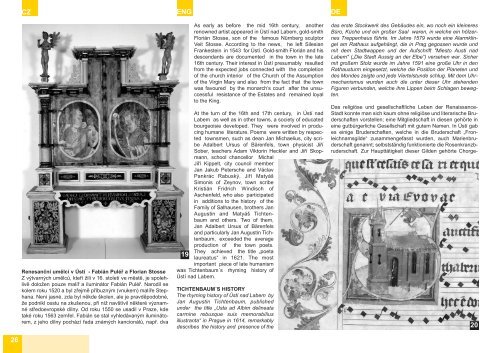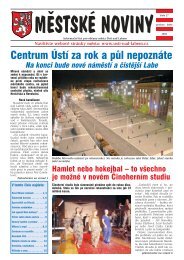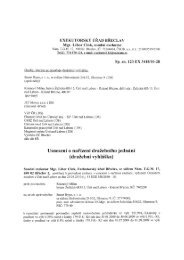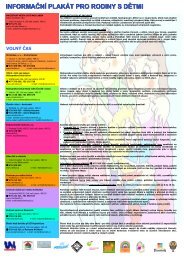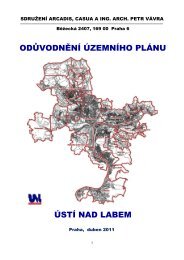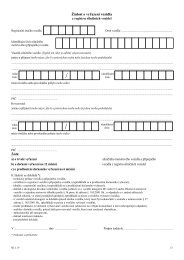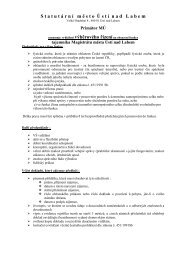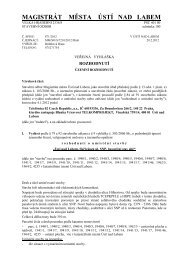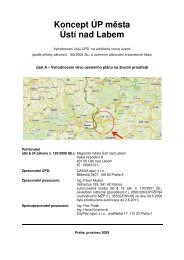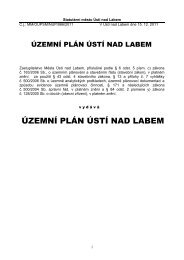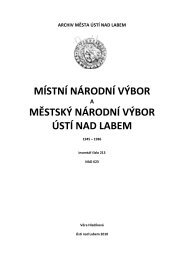Historie a památky města Ústí nad Labem History and monuments of ...
Historie a památky města Ústí nad Labem History and monuments of ...
Historie a památky města Ústí nad Labem History and monuments of ...
Erfolgreiche ePaper selbst erstellen
Machen Sie aus Ihren PDF Publikationen ein blätterbares Flipbook mit unserer einzigartigen Google optimierten e-Paper Software.
26<br />
CZ ENG DE<br />
Renesanční umělci v <strong>Ústí</strong> - Fabián Puléř a Florian Stosse<br />
Z výtvarných umělců, kteří žili v 16. století ve městě, je spolehlivě<br />
doložen pouze malíř a iluminátor Fabián Puléř. Narodil se<br />
kolem roku 1520 a byl zřejmě příbuzným (vnukem) malíře Stephana.<br />
Není jasné, zda byl někde školen, ale je pravděpodobné,<br />
že podnikl cestu na zkušenou, při níž navštívil některé významné<br />
středoevropské dílny. Od roku 1550 se usadil v Praze, kde<br />
také roku 1563 zemřel. Fabián se stal vyhledávaným iluminátorem,<br />
z jeho dílny pochází řada známých kancionálů, např. dva<br />
As early as before the mid 16th century, another<br />
renowned artist appeared in <strong>Ústí</strong> <strong>nad</strong> <strong>Labem</strong>, gold-smith<br />
Florián Stosse, son <strong>of</strong> the famous Nürnberg sculptor<br />
Veit Stosse. According to the news, he left Silesian<br />
Frankestein in 1543 for <strong>Ústí</strong>. Gold-smith Florián <strong>and</strong> his<br />
descendants are documented in the town in the late<br />
16th century. Their interest in <strong>Ústí</strong> presumably resulted<br />
from the expected jobs connected with the completion<br />
<strong>of</strong> the church interior <strong>of</strong> the Church <strong>of</strong> the Assumption<br />
<strong>of</strong> the Virgin Mary <strong>and</strong> also from the fact that the town<br />
was favoured by the monarch’s court after the unsuccessful<br />
resistance <strong>of</strong> the Estates <strong>and</strong> remained loyal<br />
to the King.<br />
At the turn <strong>of</strong> the 16th <strong>and</strong> 17th century, in <strong>Ústí</strong> <strong>nad</strong><br />
<strong>Labem</strong> as well as in other towns, a society <strong>of</strong> educated<br />
bourgeoisie developed. They were involved in producing<br />
humane literature. Poems were written by respected<br />
townsmen, such as dean Jan Michaelius, city scribe<br />
Adalbert Ursus <strong>of</strong> Bärenfels, town physicist Jiří<br />
Sober, teachers Adam Viktorin Heckler <strong>and</strong> Jiří Skopmann,<br />
school chancellor Michal<br />
Jiří Kippelt, city council member<br />
Jan Jakub Petersche <strong>and</strong> Václav<br />
Pankrác Rabuský, Jiří Matyáš<br />
Simonis <strong>of</strong> Zeynov, town scribe<br />
Kristián Fridrich Windisch <strong>of</strong><br />
19<br />
Aschenfeld, who also participated<br />
in additions to the history <strong>of</strong> the<br />
Family <strong>of</strong> Salhausen, brothers Jan<br />
Augustin <strong>and</strong> Matyáš Tichtenbaum<br />
<strong>and</strong> others. Two <strong>of</strong> them,<br />
Jan Adalbert Ursus <strong>of</strong> Bärenfels<br />
<strong>and</strong> particularly Jan Augustin Tichtenbaum,<br />
exceeded the average<br />
production <strong>of</strong> the town poets.<br />
They achieved the title „poeta<br />
laureatus“ in 1621. The most<br />
important piece <strong>of</strong> late humanism<br />
was Tichtenbaum´s rhyming history <strong>of</strong><br />
<strong>Ústí</strong> <strong>nad</strong> <strong>Labem</strong>.<br />
TICHTENBAUM´S HISTORY<br />
The rhyming history <strong>of</strong> <strong>Ústí</strong> <strong>nad</strong> <strong>Labem</strong> by<br />
Jan Augustin Tichtenbaum, published<br />
under the title „Usta ad Albim delineata<br />
carmine rebusque suis memorabilius<br />
illustranta“ in Prague in 1614, remarkably<br />
describes the history <strong>and</strong> presence <strong>of</strong> the<br />
das erste Stockwerk des Gebäudes ein, wo noch ein kleineres<br />
Büro, Küche und ein großer Saal waren, in welche ein hölzernes<br />
Treppenhaus führte. Im Jahre 1579 wurde eine Alarmklingel<br />
am Rathaus aufgehängt, die in Prag gegossen wurde und<br />
mit dem Stadtwappen und der Aufschrift "Miesto Austi <strong>nad</strong><br />
<strong>Labem</strong>" („Die Stadt Aussig an der Elbe“) versehen war. Sicher<br />
mit großem Stolz wurde im Jahre 1591 eine große Uhr in den<br />
Rathausturm eingesetzt, welche die Position der Planeten und<br />
des Mondes zeigte und jede Viertelstunde schlug. Mit dem Uhrmechanismus<br />
wurden auch die unter dieser Uhr stehenden<br />
Figuren verbunden, welche ihre Lippen beim Schlagen bewegten.<br />
Das religiöse und gesellschaftliche Leben der Renaissance-<br />
Stadt konnte man sich kaum ohne religiöse und literarische Bruderschaften<br />
vorstellen; eine Mitgliedschaft in diesen gehörte in<br />
eine gutbürgerliche Gesellschaft mit gutem Namen. In <strong>Ústí</strong> gab<br />
es einige Bruderschaften, welche in die Bruderschaft „Fronleichnamsgilde“<br />
zusammengefasst wurden, auch Marienbruderschaft<br />
genannt; selbstständig funktionierte die Rosenkranzbruderschaft.<br />
Zur Haupttätigkeit dieser Gilden gehörte Chorge-<br />
20


